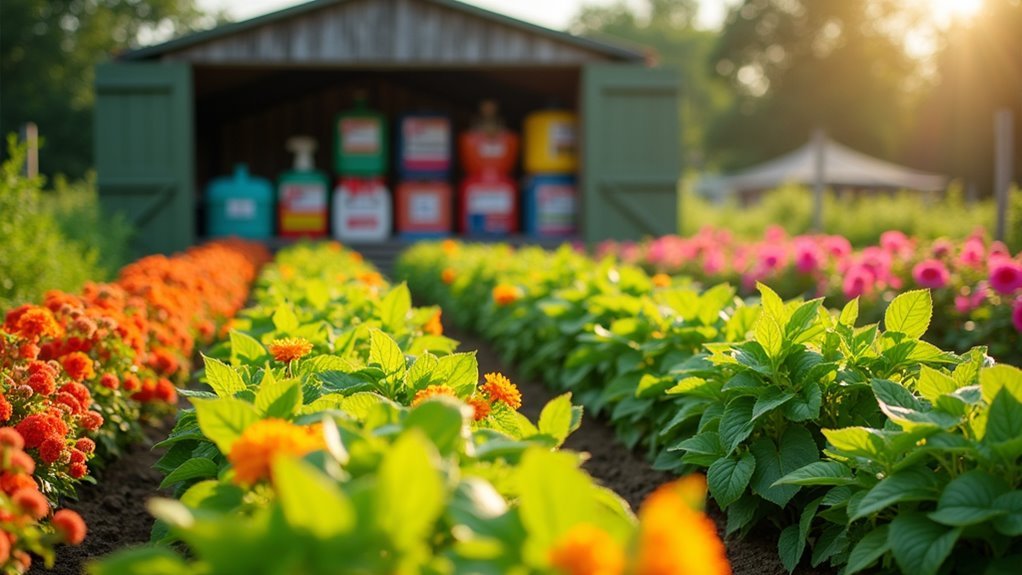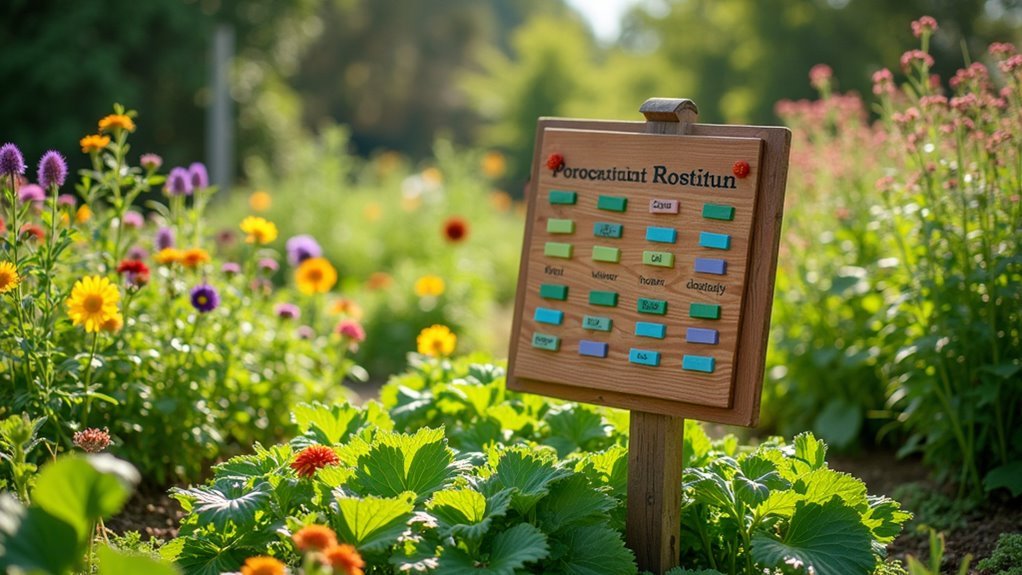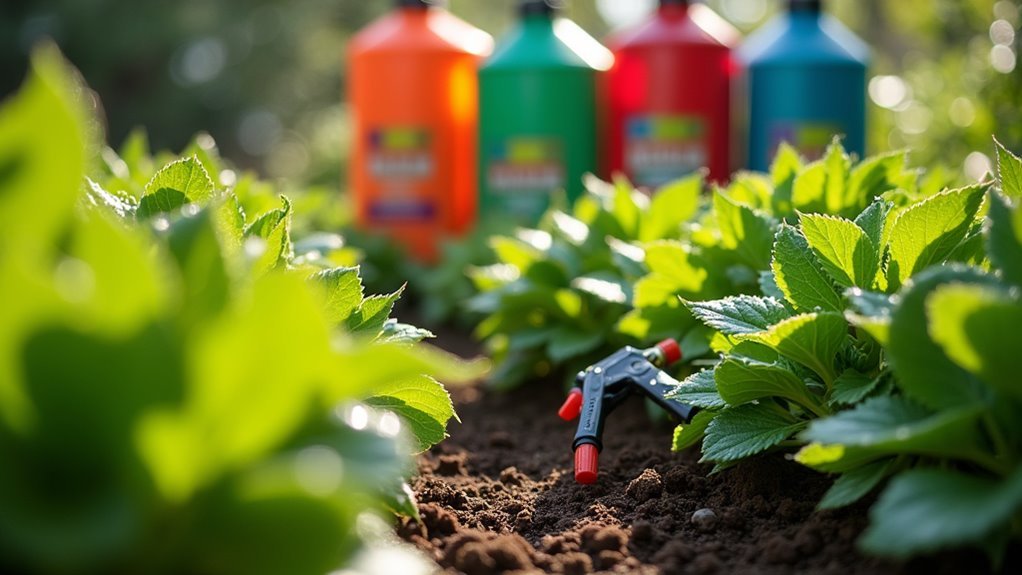You’ll prevent pesticide resistance by rotating different modes of action throughout your growing season based on pest life cycles. Start with Group 4 neonicotinoids for early spring aphids, switch to Group 3A pyrethroids for summer beetles, then alternate back for fall treatments. Track pest populations weekly and document treatment responses to identify resistance signs. Integrate non-chemical methods like companion planting and crop rotation between applications. This thorough approach will reveal advanced strategies for maximizing your garden’s long-term health.
Understanding Pesticide Mode of Action Classifications

When you’re developing an effective pesticide rotation strategy, understanding mode of action (MoA) classifications becomes your foundation for preventing resistance.
The Insecticide Resistance Action Committee has created a numbering system that categorizes pesticides by their specific biochemical targets. You’ll find Group 4 neonicotinoids attack insect nervous systems differently than Group 3A pyrethroids, even though both affect nerve function.
Understanding pesticide classifications by biochemical targets enables strategic rotation between different modes of action for effective resistance management.
This classification system empowers you to make informed decisions about product rotation. Instead of repeatedly using similar products, you can alternate between different MoA groups throughout the season.
This approach forms the cornerstone of effective resistance management and aligns perfectly with Integrated Pest Management principles. By varying your pesticide modes of action, you’ll maintain long-term efficacy while protecting these valuable tools for future use.
Identifying Peak Pest Activity Periods Throughout the Year
You’ll need to track when different pests reach their peak activity levels throughout the growing season to time your pesticide rotations effectively.
Understanding each pest’s life cycle helps you predict when populations will surge, as many species like diamondback moths can produce multiple generations within a single year.
Seasonal Pest Life Cycles
Since most garden pests follow predictable seasonal pest life cycles, you can anticipate their arrival and rotate pesticides accordingly. Understanding these cycles helps you target pest populations when they’re most vulnerable and prevents resistance development through strategic timing.
Key seasonal patterns include:
- Early spring – Aphids emerge as temperatures rise and sap begins flowing
- Late spring – Cabbage worms appear when cool-season crops are establishing
- Summer – Cucumber beetles and Japanese beetles peak during warm months
- Fall – Many pests enter dormancy, making it ideal for crop rotation
- Winter – Planning period for next year’s rotation strategy
You’ll maximize pesticide effectiveness by aligning applications with these natural cycles.
Monitor local pest activity patterns and maintain detailed records to refine your seasonal rotation approach each year.
Monitoring Activity Patterns
Most successful gardeners develop a systematic approach to tracking pest activity by maintaining detailed records of when specific pests appear, reach peak populations, and decline throughout each growing season.
You’ll want to create a detailed garden journal that documents pest sightings, weather conditions, and plant health status. This monitoring practice reveals essential patterns that align with pest life cycles, enabling you to anticipate infestations before they become severe.
Record the timing and intensity of each pest encounter, noting specific dates when populations surge. For instance, diamondback moths typically peak during spring months, requiring early intervention strategies.
Creating Your Annual Pesticide Rotation Calendar

You’ll need to map out specific application windows that align with your local growing season and pest emergence patterns.
Start by scheduling different pesticide modes of action across spring, summer, and fall periods, ensuring you’re not repeating the same chemical class within consecutive applications.
This systematic approach requires you to balance timing with mode rotation, creating a framework that maximizes pest control while minimizing resistance development.
Seasonal Application Planning
When you’re developing an annual pesticide rotation calendar, timing becomes your most powerful weapon against pest resistance. You’ll need to synchronize your rotation plan with pest life cycles, striking when they’re most vulnerable.
Your seasonal pest control strategy should include:
- Spring preparation – Target overwintering pests emerging from dormancy with your first pesticide class
- Early summer focus – Apply different modes of action during peak breeding cycles
- Mid-season adjustments – Switch to your third pesticide class as populations mature
- Late season management – Use targeted applications before pests prepare for winter
- Winter planning – Schedule cover crops and fallow periods to enhance soil health
Monitor pest activity throughout each season and adjust your calendar accordingly. This data-driven approach guarantees you’re always one step ahead of developing resistance patterns.
Mode Rotation Scheduling
Since effective resistance management hinges on systematic pesticide rotation, developing a thorough mode of action schedule forms the backbone of your annual pest control strategy. You’ll need to categorize your insecticides by their specific control methods, ensuring different classes target pest life cycles during successive treatments.
| Season | Primary Mode of Action |
|---|---|
| Spring | Organophosphates (IRAC 1B) |
| Summer | Pyrethroids (IRAC 3A) |
| Fall | Neonicotinoids (IRAC 4A) |
Your rotation strategies must prevent consecutive applications of identical modes for at least two pest generations. Schedule treatments according to vulnerable life stages, timing applications around planting and harvesting when pest activity peaks. Monitor populations regularly and adjust your calendar accordingly, maintaining detailed records of dates, treatments, and observed pest pressure to refine future rotations.
Spring Pesticide Applications and Target Pests
As temperatures climb above 50°F, you’ll need to target early-season pests like aphids and spider mites that emerge from winter dormancy.
Spring timing is critical since these pests reproduce rapidly—a single female aphid can produce 100 offspring weekly, creating massive infestations if left unchecked.
Your spring rotation strategy should include:
- Systemic insecticides for long-lasting protection against whiteflies and leafhoppers
- Different modes of action to prevent resistance development in pest populations
- Close monitoring of emerging pest populations as temperatures rise
- Biological control methods like releasing ladybugs alongside chemical treatments
- Early intervention targeting before pests establish large populations
Integrating these approaches creates a thorough spring management plan that reduces chemical reliance while maintaining effective control against early-season threats.
Summer Heat Management With Rotating Treatments

Summer heat intensifies pest activity and accelerates reproduction cycles, making your rotation strategy even more critical during these peak months.
You’ll need to switch pesticides with different modes of action every few weeks since rotation can disrupt pest resistance development that occurs rapidly in warmer temperatures.
Apply treatments early morning or late evening when beneficial insects are less active and cooler temperatures prevent chemical degradation.
Timing pesticide applications during cooler hours protects beneficial insects while preventing heat-induced chemical breakdown for maximum treatment effectiveness.
Consider systemic insecticides for extended protection during hot weather, reducing application frequency while maintaining effectiveness.
Monitoring pest populations bi-weekly helps you time applications with peak activity periods.
Incorporate non-chemical methods like introducing beneficial insects and maintaining plant diversity to complement your management program.
This integrated approach enhances your summer pest control strategy while protecting helpful species.
Fall Prevention Strategies and Overwintering Pest Control
You’ll need to shift your pest control strategy as fall arrives, focusing on preventing overwintering populations from establishing themselves in your garden.
Start by identifying which pests typically survive winter in your area, then time your treatments to disrupt their preparation for dormancy.
Apply targeted interventions during late fall when pests are settling into their winter hiding spots, and consider dormancy applications that’ll work throughout the cold months.
Identifying Overwintering Pests
Why wait until spring to discover pest problems when you can identify and eliminate overwintering threats during fall?
You’ll find overwintering pests hiding in plant debris, soil cracks, and garden corners where they’re preparing for dormancy. Recognizing these early warning signs helps you manage pests before they become spring infestations.
Key identification markers include:
- Leaf discoloration patterns indicating aphid or spider mite activity
- Unusual insect movement around plant bases and debris piles
- Webbing or egg masses on plant stems and branches
- Tiny holes or feeding damage on remaining foliage
- Clustering insects seeking shelter under mulch layers
When you disrupt pest life cycles through early detection, you’ll reduce the need for aggressive treatments later.
Proper identification determines whether insecticides are used immediately or if sanitation practices alone will suffice.
Fall Treatment Timing
Once you’ve identified overwintering pests, strategic timing becomes your most powerful weapon against spring infestations. Fall treatment timing targets vulnerable life cycles before pests enter dormancy, maximizing control effectiveness.
| Timing Strategy | Implementation |
|---|---|
| Pre-Dormancy Applications | Apply treatments when overwintering pests are active but vulnerable |
| Cultural Controls | Remove debris and dead plants creating unfavorable overwintering conditions |
| Cover Crop Integration | Plant rye or hairy vetch to suppress pests while improving soil health |
| Monitoring Schedule | Track pest populations for targeted, precise treatment decisions |
Implementing integrated pest management during fall requires you to rotate pesticide modes of action, preventing resistance development. Combine chemical treatments with cultural practices for thorough control. This strategic approach reduces spring emergence rates considerably, giving you the upper hand next growing season.
Winter Dormancy Applications
While temperatures drop and pests prepare for winter dormancy, your preventive applications become critical for breaking their reproductive cycles.
Winter dormancy applications require strategic timing to eliminate overwintering pests before they become spring problems.
Focus your efforts on these essential preventive measures:
- Apply horticultural oils or insecticidal soaps before freezing temperatures to suffocate eggs and larvae
- Plant cover crops like rye to create unfavorable conditions for pest survival
- Monitor for late-season aphids and spider mites requiring targeted treatments
- Preserve beneficial insects like ladybugs and lacewings through careful application timing
- Coordinate pesticide schedules with pest life cycles for maximum effectiveness
You’ll achieve the best results by treating vulnerable pest stages while protecting beneficial insects that’ll support your garden’s health throughout the dormant season.
Winter Dormant Season Applications
When temperatures consistently drop below 50°F, you’ll find the winter dormant season presents an ideal window for strategic pesticide applications.
During this period, your trees and shrubs become less metabolically active, allowing systemic treatments to absorb more effectively into plant tissues.
You’ll want to target overwintering pests like aphids, scales, and spider mites before bud break occurs. This timing prevents damage to emerging growth while maximizing treatment effectiveness.
Dormant oil applications work particularly well now, suffocating pests and disrupting their pest cycles without harming dormant plants.
Monitor weather conditions closely after application, as rainfall or temperature fluctuations can reduce pesticide efficacy.
The reduced risk of pesticide drift during cooler temperatures makes this season advantageous for controlling pests that overwinter in plant tissues.
Selecting Compatible Pesticide Groups for Effective Rotation
After establishing your dormant season treatment plan, you’ll need to strategically select pesticide groups that work together effectively throughout the growing season. Understanding modes of action becomes essential for preventing resistance development in pest populations.
The Insecticide Resistance Action Committee (IRAC) provides a classification system that guides your rotation strategy:
- Alternate between different IRAC groups, such as Group 3A pyrethroids followed by Group 4A neonicotinoids
- Mix systemic and contact insecticides to target pests through multiple pathways
- Time applications based on pest life cycles for maximum effectiveness
- Monitor pest populations regularly to assess rotation success
- Avoid consecutive applications from the same chemical group
When rotating insecticides, you’ll target different pest stages while reducing chemical dependency, ensuring your seasonal pest management remains effective long-term.
Monitoring Pest Resistance Development in Your Garden
Even with a well-planned rotation strategy, you’ll need to actively monitor your garden for signs that pests are developing resistance to your treatments. Keep detailed records of pest occurrences and pesticide effectiveness to track resistance trends over time. Watch for changes in pest behavior or population density despite consistent applications.
| Monitoring Method | What to Track | Action Needed |
|---|---|---|
| Population Counts | Weekly pest numbers | Note unusual increases |
| Treatment Response | Pesticide effectiveness | Document reduced control |
| Behavioral Changes | Pest activity patterns | Record timing shifts |
Collaborate with local agricultural extension services for regional resistance data. This extensive monitoring approach helps you identify early resistance development and adjust your pest management strategy before problems become severe.
Record Keeping Systems for Tracking Application Success
You’ll need to track specific data points to measure your pesticide rotation’s effectiveness and identify which treatments work best against different pests.
Whether you choose digital spreadsheets or traditional paper logs, your system must capture application dates, products used, pest populations, and environmental conditions consistently.
The key isn’t which format you select, but rather ensuring you’re collecting the right information to make informed decisions about future applications.
Essential Tracking Data Points
While rotating pesticides requires careful planning, tracking your applications through systematic record keeping transforms guesswork into data-driven decisions.
You’ll need to capture specific data points that reveal patterns and effectiveness across your seasonal rotation strategy. Your tracking system should document these essential elements:
- Application details – Record dates, pesticide types, targeted pests, and environmental conditions like temperature and humidity during each treatment
- Pest population assessments – Monitor pest numbers before and after applications to measure treatment success
- Beneficial insects impact – Note any adverse effects on pollinators, predators, and other helpful garden allies
- Resistance indicators – Track declining effectiveness that signals potential resistance development
- Rotation timeline – Establish schedules for switching between different pesticide classes and modes of action
Digital Vs Paper Systems
Once you’ve identified your essential tracking data points, choosing between digital and paper record-keeping systems becomes your next critical decision.
Digital record-keeping offers real-time tracking of pesticide applications, automatically recording dates, types, and quantities with enhanced accuracy. You’ll benefit from features like reapplication reminders and pest monitoring analytics that inform future treatment decisions. These systems integrate seamlessly with other agricultural tools, providing thorough overviews of your pest management strategies and their effectiveness over time.
Paper systems require diligent organization and risk damage or loss, making historical data retrieval challenging during critical planning periods.
However, regardless of your chosen method, regularly updating records guarantees compliance with regulatory requirements and demonstrates responsible pesticide use during inspections.
Integrating Non-Chemical Methods Between Pesticide Rotations
Between pesticide applications, incorporating non-chemical pest management methods creates a powerful foundation that amplifies your rotation strategy’s effectiveness.
Integrating non-chemical methods disrupts pest cycles naturally, reducing your dependence on chemical treatments while maintaining excellent control.
- Crop rotation breaks pest life cycles by removing their preferred host plants seasonally.
- Companion planting with marigolds and basil attracts natural enemies while repelling harmful insects.
- Cover crops during off-seasons improve soil health and create hostile environments for overwintering pests.
- Mechanical controls like traps and barriers reduce pest pressure between chemical applications.
- Garden cleanliness removes debris and diseased plants that harbor pest populations.
These methods work synergistically with your pesticide rotation schedule, creating multiple pressure points that prevent pest adaptation and resistance development.
Adjusting Rotation Schedules Based on Weather Patterns
Weather conditions greatly influence both pest behavior and pesticide effectiveness, making schedule adjustments essential for maintaining ideal control throughout the growing season.
When adjusting rotation schedules based on weather patterns, you’ll need to monitor rainfall closely since increased precipitation creates favorable breeding conditions that boost pest populations, requiring more frequent pesticide applications.
Warmer temperatures accelerate pest life cycles, so you should time applications to coincide with peak activity periods.
During drought conditions, you can extend intervals between treatments as pest populations typically decline.
Temperature and humidity variations affect pesticide efficacy, so check weather forecasts before applications.
Keep detailed records of weather patterns and pest activity to inform future rotation schedule adjustments and improve your management strategies.
Safety Protocols for Handling Multiple Pesticide Types
While rotating multiple pesticide types provides effective pest control, you must prioritize safety protocols to protect yourself and others during handling and application.
Effective pest management requires strict adherence to safety protocols when handling and applying multiple pesticide types throughout the growing season.
Following proper procedures guarantees you’ll avoid dangerous exposure while maintaining effective pest management throughout the season.
Essential safety protocols include:
- Always read label instructions for each pesticide type before use, as requirements vary between products.
- Wear appropriate personal protective equipment including gloves, masks, goggles, and long-sleeve clothing during all handling activities.
- Store different pesticide types in original containers with clear labeling in cool, dry locations away from children and pets.
- Never mix pesticides unless labels specifically allow it, and perform compatibility tests when necessary.
- Dispose of pesticide containers according to local regulations while maintaining a clean workspace.
Evaluating Long-Term Effectiveness of Your Rotation Strategy
After implementing proper safety protocols, you’ll need to systematically evaluate whether your rotation strategy delivers the pest control results you expect.
Monitor your crops regularly to track the total number of pests present and assess if resistance increases over time. Keep detailed records of application dates, pesticide types, and pest responses to identify which combinations work best.
Conduct seasonal evaluations to detect declining effectiveness, which signals potential resistance development across multiple generations. Your systematic rotation plan should include different modes of action, ideally changing pesticide types every 30 days to disrupt pest life cycles effectively.
Collaborate with local agricultural extension services for expert guidance on resistance management and long-term strategy optimization based on your documented results.
Frequently Asked Questions
How Long After Spraying Pesticides Indoors Is It Safe for Humans?
You should wait 2-4 hours minimum after spraying indoor pesticides before re-entering. Check the product label’s re-entry interval, which can range from 4-24 hours depending on the pesticide’s chemical composition.
How Do You Rotate Pesticides?
You’ll rotate pesticides by switching between different classes or modes of action for each application. Use IRAC guidelines, establish 30-day intervals based on pest life cycles, and maintain detailed records.
How Do I Clean My House After Pesticide?
Ventilate your home for 2-3 hours by opening windows. Clean all surfaces with soapy water, wash exposed fabrics in hot water, and mop floors with a HEPA vacuum to remove pesticide residue.
How Often Should You Spray Pesticide Around Your House?
You should spray pesticide around your house every 7-21 days, depending on the product and pest type. Follow manufacturer instructions, monitor pest activity regularly, and rotate pesticide classes every 2-3 applications.
In Summary
You’ll maximize your pest control success by implementing a well-planned seasonal rotation strategy. Remember to consistently monitor your property for pest activity changes and adjust your rotation calendar accordingly. Don’t forget to integrate non-chemical methods between applications to reduce overall pesticide dependence. Keep detailed records of what you’ve used and when, so you can refine your approach each year and maintain effective, sustainable pest management.





Leave a Reply